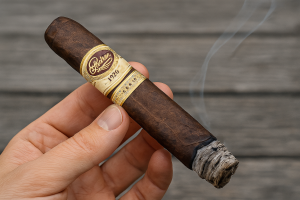How to Season a Cigar Humidor: Easy 3-Step Process

Stepping into the world of cigar aficionados, seasoning a cigar humidor is not just a task.
It’s an art form, essential for unlocking the full potential of your prized collection.
Maintaining the ideal humidity level is crucial for preserving the flavor and integrity of your cherished stogies. Therefore, in this blog post, we will go step by step to show you how to season a cigar humidor to perfection, so let’s jump into it.
- Seasoning the Humidor Made Simple
- Step 1: Humidification Process
- Step 2: Allowing the Humidor to Season
- Step 3: Maintaining and Tracking Humidity Levels
- Understanding the Basics of a Humidor
- Preparing the Humidor for Seasoning
- FAQs
How to Season a Cigar Humidor - Step-By-Step Process
Proper seasoning of a humidor is essential to create the ideal environment for cigar storage, ensuring they remain fresh and retain their flavor. It stabilizes the internal humidity, preventing cigars from becoming too dry or too moist.
This process is key to preserving the quality and longevity of your cigars, enhancing your smoking experience. Here are the three steps to follow in this process.
Step 1: Humidification Process
This is the initial, and most important step. There are a few things involved in the process, and you should master every part of it to ensure the safety and longevity of your cigars.
-
Hygrometer Calibration
To calibrate your hygrometer, you can perform a salt test or use a Boveda calibration kit. The salt test involves placing a hygrometer and a small amount of salt in a sealed container. Allow it to stabilize for a few hours, and the hygrometer should read 75%.
If it doesn't, adjust the calibration accordingly. The Boveda calibration kit is a convenient alternative that simplifies the process.
-
Prepare the Humidification Device
Humidification devices are essential for maintaining humidity within the humidor. There are various options available, including active humidifiers and Boveda packs.
Before seasoning, ensure that you have the appropriate device and it's ready for use.
-
Apply Distilled Water to the Humidor
Moistening the interior of the humidor is a critical step in the seasoning process. The objective is to condition the wood by gradually absorbing moisture. Distilled water should be used to prevent impurities from affecting the cigars.
Dampen a clean sponge or cloth with distilled water. Carefully wipe down the interior surfaces of the humidor, including the walls, trays, and dividers. Ensure that they are lightly moistened but not soaked. Excess water can damage the humidor and affect the cigars adversely.
-
Placement and Monitoring
After preparing the humidor, it's time to position various elements and monitor the humidity levels.
Place the damp sponge or cloth and the prepared humidification device inside the humidor. The sponge helps maintain humidity levels during the seasoning process, while the humidification device will be responsible for regulating humidity in the long term.
Alongside the sponge, place a small dish filled with distilled water. This additional source of moisture will help maintain humidity. Ensure that the dish is stable and will not spill water into the humidor.
Close the humidor and ensure a tight seal. This will prevent moisture from escaping and allow the wood to absorb the humidity slowly.
It's important to monitor the humidity levels during the seasoning process. Keep an eye on the hygrometer readings regularly to ensure the humidity remains within the desired range. If the levels drop significantly, you may need to add a little more distilled water to the sponge.
Step 2: Allow the Humidor to Season
Proper seasoning takes time and patience. It's recommended to let the humidor season for about two weeks to allow the wood to absorb the optimal moisture gradually. Rushing the process may result in inadequate seasoning and unstable humidity levels, compromising the quality of your cigars.
Throughout this period, resist the temptation to prematurely store your cigars in the humidor. Instead, use this time to prepare your prized stogies, ensuring they are in the optimum condition for storage.
Step 3: Maintain and Track Humidity Levels
Once your humidor is correctly seasoned, you need to maintain the desired humidity levels to preserve the flavor of your cigars. Follow these tips to achieve consistent humidity:
- Regularly check and replenish the humidification device. Depending on the device, this may involve adding distilled water or replacing humidification packs.
- Keep an eye on the water dish and refill it whenever necessary to prevent it from drying out.
- Consider using a digital hygrometer for more accurate and convenient humidity readings.
- Monitoring and maintaining proper humidity levels will ensure that your cigars age gracefully and remain in perfect condition for years to come.
Understanding the Basics of a Humidor
A humidor is a specially designed storage container that helps maintain a stable environment for cigars. It protects them from temperature fluctuations and ensures proper humidity levels. There are various types of humidors available, including desktop humidors, cabinet humidors, and travel humidors. Understanding the essentials of a humidor will help you choose the most suitable option for your needs.
When it comes to aging cigars, seasoned humidors provide the perfect environment. A seasoned humidor has been properly prepared to hold optimal humidity levels, promoting a slow and controlled aging process. Let's delve into the process of seasoning a humidor to get started.
Preparing the Humidor for Seasoning
Before beginning the seasoning process, it's essential to gather all the necessary tools and ensure that your humidor is ready.
First, make sure you have a hygrometer, which measures humidity levels, distilled water, a clean sponge or cloth, and a small dish.
Remove any packaging, tags, or protective materials from your humidor. This will allow the wood to properly absorb and retain moisture during the seasoning process.
Inspect the humidor's seal carefully. Ensure that there are no cracks, gaps, or leaks that could interfere with the humidity control. A well-sealed humidor is essential for maintaining consistent moisture levels.
FAQs
Can I speed up the humidor seasoning process?
No, speeding up the process is not recommended. Quick seasoning methods can unevenly distribute moisture, potentially warping the wood and leading to inconsistent humidity levels.
How often should I recalibrate my hygrometer?
It's advisable to recalibrate your hygrometer every 6 months to ensure accurate readings, especially if there are significant changes in your environment's climate.
Is there a risk of over-seasoning my humidor?
Yes, over-seasoning can occur if too much moisture is introduced too quickly. This can cause the wood to swell and damage the humidor's seal, impacting its ability to regulate humidity effectively.
Can I use tap water instead of distilled water for seasoning?
It's not recommended to use tap water as it contains minerals and impurities. These substances can damage the humidor and affect the taste of your cigars.
How do I know when my humidor is properly seasoned?
A humidor is considered properly seasoned when it consistently maintains the desired humidity level (65-72%) for several days without needing to add more water.
How long to season a humidor?
Seasoning a humidor, which involves preparing it to maintain the right humidity for cigars, typically takes about one to two weeks.
How often should I season my humidor?
Once properly seasoned, a humidor shouldn't need frequent re-seasoning; it's more about maintaining consistent humidity, so re-seasoning might only be necessary if there are significant changes in humidity or if the humidor hasn't been used for an extended period.
Why is my humidor not keeping humidity?
This could be due to several reasons like a poor seal, incorrect humidification device, uncalibrated hygrometer, or inadequate seasoning. Environmental factors like room temperature and humidity also play a role.















